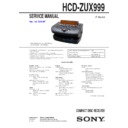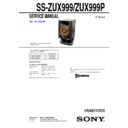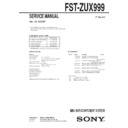Read Sony FST-ZUX999 / HCD-ZUX999 Service Manual online
SERVICE MANUAL
Sony Corporation
Audio&Video Business Group
Published by Sony Techno Create Corporation
HCD-ZUX999
SPECIFICATIONS
COMPACT DISC RECEIVER
9-889-579-01
2009G04-1
©
2009.07
E Model
Ver. 1.0 2009.07
• HCD-ZUX999 is the tuner, CD, USB and
amplifi er section in FST-ZUX999.
Amplifi er section
The following measured at AC 127 V, 60 Hz
(Mexican model)
The following measured at AC 120, 220,
240 V, 50/60 Hz (Other models)
The following measured at AC 127 V, 60 Hz
(Mexican model)
The following measured at AC 120, 220,
240 V, 50/60 Hz (Other models)
Front/Rear speaker:
Power output (rated):
Power output (rated):
160 W + 160 W (at 6
Ω, 1 kHz,
1%
THD)
RMS output power (reference):
250 W + 250 W/250 W + 250 W
(per channel at 6
Ω, 1 kHz, 10%
THD)
Inputs
AUDIO IN 1, 2 L/R:
AUDIO IN 1, 2 L/R:
voltage 250 – 700 mV, impedance
47
kilohms
MIC: sensitivity 1 mV, impedance
10
10
kilohms
Outputs
i
i
(Headphones):
accepts headphones with an
impedance of 8
Ω or more
FRONT/REAR SPEAKER:
Use only the supplied speaker
SS-ZUX999
USB section
Supported bit rate:
Supported bit rate:
MP3 (MPEG 1 Audio Layer-3):
32 – 320 kbps, VBR
WMA: 48 – 192 kbps, VBR
AAC: 48 – 320 kbps
Sampling frequencies:
MP3 (MPEG 1 Audio Layer-3):
32/44.1/48
kHz
WMA: 44.1 kHz
AAC: 44.1 kHz
(USB 1 and USB 2) port: Type A
Maximum current: 500 mA
– Continued on next page –
CD player section
System:
System:
Compact disc and digital audio
system
Laser Diode Properties
Laser Diode Properties
Emission duration: Continuous
Laser Output*: Less than 44.6
μW
* This output is the value measurement
at a distance of 200mm from the
objective lens surface on the Optical
Pick-up Block with 7mm aperture.
Frequency response:
20 Hz – 20 kHz
Tuner section
FM stereo, FM/AM superheterodyne tuner
Antenna:
FM stereo, FM/AM superheterodyne tuner
Antenna:
FM lead antenna
AM loop antenna
Model Name Using Similar Mechanism
New
Mechanism Type
CDM74KF-F2BD82F-A
Base Unit Name
BU-F2BD82F-A
Optical Pick-up Name
KSM-215DHAP
• “WALKMAN” and “WALKMAN” logo are registered trademarks of
Sony Corporation.
• “Memory Stick” is a trademark of Sony Corporation.
• MPEG Layer-3 audio coding technology and patents licensed from
• MPEG Layer-3 audio coding technology and patents licensed from
Fraunhofer IIS and Thomson.
• Windows Media is a registered trademark of Microsoft Corporation
in the United States and/or other countries.
HCD-ZUX999
2
UNLEADED SOLDER
Boards requiring use of unleaded solder are printed with the lead-
free mark (LF) indicating the solder contains no lead.
(Caution: Some printed circuit boards may not come printed with
Boards requiring use of unleaded solder are printed with the lead-
free mark (LF) indicating the solder contains no lead.
(Caution: Some printed circuit boards may not come printed with
the lead free mark due to their particular size)
: LEAD FREE MARK
Unleaded solder has the following characteristics.
• Unleaded solder melts at a temperature about 40 °C higher
• Unleaded solder melts at a temperature about 40 °C higher
than ordinary solder.
Ordinary soldering irons can be used but the iron tip has to be
applied to the solder joint for a slightly longer time.
applied to the solder joint for a slightly longer time.
Soldering irons using a temperature regulator should be set to
about 350 °C.
Caution: The printed pattern (copper foil) may peel away if
about 350 °C.
Caution: The printed pattern (copper foil) may peel away if
the heated tip is applied for too long, so be careful!
• Strong
viscosity
Unleaded solder is more viscous (sticky, less prone to fl ow)
than ordinary solder so use caution not to let solder bridges
occur such as on IC pins, etc.
than ordinary solder so use caution not to let solder bridges
occur such as on IC pins, etc.
•
Usable with ordinary solder
It is best to use only unleaded solder but unleaded solder may
also be added to ordinary solder.
also be added to ordinary solder.
NOTES ON CHIP COMPONENT REPLACEMENT
•
•
Never reuse a disconnected chip component.
•
Notice that the minus side of a tantalum capacitor may be dam-
aged by heat.
aged by heat.
FLEXIBLE CIRCUIT BOARD REPAIRING
•
•
Keep the temperature of soldering iron around 270 °C during
repairing.
repairing.
•
Do not touch the soldering iron on the same conductor of the
circuit board (within 3 times).
circuit board (within 3 times).
•
Be careful not to apply force on the conductor when soldering
or unsoldering.
or unsoldering.
SAFETY-RELATED COMPONENT WARNING!
COMPONENTS IDENTIFIED BY MARK
0 OR DOTTED LINE
WITH MARK
0 ON THE SCHEMATIC DIAGRAMS AND IN
THE PARTS LIST ARE CRITICAL TO SAFE OPERATION.
REPLACE THESE COMPONENTS WITH SONY PARTS
REPLACE THESE COMPONENTS WITH SONY PARTS
WHOSE PART NUMBERS APPEAR AS SHOWN IN THIS
MANUAL OR IN SUPPLEMENTS PUBLISHED BY SONY.
MANUAL OR IN SUPPLEMENTS PUBLISHED BY SONY.
FM tuner section:
Tuning range:
Tuning range:
87.5 – 108.0 MHz (50 kHz step)
Intermediate frequency: 10.7 MHz
AM tuner section:
Tuning range:
Latin
AM tuner section:
Tuning range:
Latin
American
models:
530 – 1,710 kHz (10 kHz step)
531 – 1,710 kHz (9 kHz step)
Other
models:
531 – 1,602 kHz (9 kHz step)
530 – 1,610 kHz (10 kHz step)
Intermediate frequency: 450 kHz
General
Power requirements
Mexican
Power requirements
Mexican
model:
AC 127 V, 60 Hz
Other
models:
AC 120, 220 or 230 – 240 V,
50/60 Hz, adjustable with voltage
selector
Power consumption
330
Power consumption
330
W
Dimensions (w/h/d) (excl. speakers)
Approx.
Approx.
506
× 342 × 513 mm
Mass (excl. speakers)
Approx. 20.0 kg
Supplied accessories: Remote Commander
(1), R6 (Size AA) batteries (2), FM lead
antenna (1), AM loop antenna (1), Speaker
cords (4)
(1), R6 (Size AA) batteries (2), FM lead
antenna (1), AM loop antenna (1), Speaker
cords (4)
Design and specifi cations are subject to
change without notice.
change without notice.
HCD-ZUX999
3
CAUTION
Use of controls or adjustments or performance of procedures
other than those specifi ed herein may result in hazardous radia-
tion exposure.
Use of controls or adjustments or performance of procedures
other than those specifi ed herein may result in hazardous radia-
tion exposure.
NOTES ON HANDLING THE OPTICAL PICK-UP
BLOCK OR BASE UNIT
BLOCK OR BASE UNIT
The laser diode in the optical pick-up block may suffer electro-
static break-down because of the potential difference generated by
the charged electrostatic load, etc. on clothing and the human body.
During repair, pay attention to electrostatic break-down and also
use the procedure in the printed matter which is included in the
repair parts.
The fl exible board is easily damaged and should be handled with
care.
static break-down because of the potential difference generated by
the charged electrostatic load, etc. on clothing and the human body.
During repair, pay attention to electrostatic break-down and also
use the procedure in the printed matter which is included in the
repair parts.
The fl exible board is easily damaged and should be handled with
care.
NOTES ON LASER DIODE EMISSION CHECK
The laser beam on this model is concentrated so as to be focused
on the disc refl ective surface by the objective lens in the optical
pickup block. Therefore, when checking the laser diode emission,
observe from more than 30 cm away from the objective lens.
The laser beam on this model is concentrated so as to be focused
on the disc refl ective surface by the objective lens in the optical
pickup block. Therefore, when checking the laser diode emission,
observe from more than 30 cm away from the objective lens.
Laser component in this product is capable of emitting radiation
exceeding the limit for Class 1.
exceeding the limit for Class 1.
This appliance is classifi ed as
a CLASS 1 LASER product.
This marking is located on the
rear exterior.
a CLASS 1 LASER product.
This marking is located on the
rear exterior.
MODEL IDENTIFICATION
– Model Number Label –
– Model Number Label –
• Abbreviation
E2
E2
: 120V AC area in E model
E3
: 240V AC area in E model
E51
: Chilean and Peruvian models
MX
: Mexican model
Model
Part No.
E2, E51 model
4-152-900-0[]
E3 model
4-152-901-0[]
MX model
4-152-903-0[]
Parts No.
HCD-ZUX999
4
TABLE OF CONTENTS
1.
SERVICING NOTES
............................................. 5
2. DISASSEMBLY
2-1. Loading Panel ................................................................ 10
2-2. Back
2-2. Back
Panel
...................................................................... 10
2-3. Top Panel Section ........................................................... 11
2-4. Side Panel (L) Assy, Side Panel (R) Assy ....................... 11
2-5. Front Panel Section ......................................................... 12
2-6. MAIN
2-4. Side Panel (L) Assy, Side Panel (R) Assy ....................... 11
2-5. Front Panel Section ......................................................... 12
2-6. MAIN
Board
................................................................... 12
2-7. CD Mechanism Deck ...................................................... 13
2-8. REGULATOR
2-8. REGULATOR
Board
...................................................... 13
2-9. PT Board, SUB PT Board ............................................... 14
2-10. AMP Board, DC FAN (FAN903).................................... 14
2-11. SPEAKER TERMINAL Board ...................................... 15
2-12. X-ROUND JOG Board ................................................... 15
2-13. RIGHT ENTER Board, LEFT ENTER Board................ 16
2-14. SH-TAS Board ................................................................ 16
2-15. PANEL FUNCTION Board ............................................ 17
2-16. LF-TUBE Board, CROSS FADER Board ...................... 17
2-17. Brackets .......................................................................... 18
2-18. MASTER VOLUME Board ........................................... 18
2-19. LEFT PANEL Board, USB-A Board .............................. 19
2-20. RIGHT PANEL Board, USB-B Board ............................ 19
2-21. BOTTOM SIRCS Board, OPEN/CLOSE KEY Board,
2-10. AMP Board, DC FAN (FAN903).................................... 14
2-11. SPEAKER TERMINAL Board ...................................... 15
2-12. X-ROUND JOG Board ................................................... 15
2-13. RIGHT ENTER Board, LEFT ENTER Board................ 16
2-14. SH-TAS Board ................................................................ 16
2-15. PANEL FUNCTION Board ............................................ 17
2-16. LF-TUBE Board, CROSS FADER Board ...................... 17
2-17. Brackets .......................................................................... 18
2-18. MASTER VOLUME Board ........................................... 18
2-19. LEFT PANEL Board, USB-A Board .............................. 19
2-20. RIGHT PANEL Board, USB-B Board ............................ 19
2-21. BOTTOM SIRCS Board, OPEN/CLOSE KEY Board,
DISC FUNCTION Board ............................................... 20
2-22. MICROPHONE Board, HEADPHONE Board .............. 20
2-23. Base Unit ......................................................................... 21
2-24. BD Board ........................................................................ 21
2-25. DRIVER Board, SW Board ............................................ 22
2-26. SENSOR Board .............................................................. 22
2-27. MOTOR (TB) Board....................................................... 23
2-28. MOTOR (LD) Board ...................................................... 23
2-23. Base Unit ......................................................................... 21
2-24. BD Board ........................................................................ 21
2-25. DRIVER Board, SW Board ............................................ 22
2-26. SENSOR Board .............................................................. 22
2-27. MOTOR (TB) Board....................................................... 23
2-28. MOTOR (LD) Board ...................................................... 23
3.
TEST MODE
............................................................ 24
4.
ELECTRICAL CHECKS
...................................... 27
5. DIAGRAMS
5-1. Block Diagram –CD Servo Section– .............................. 30
5-2. Block Diagram –Audio Section– .................................... 31
5-3. Block Diagram –USB Section– ...................................... 32
5-4. Block Diagram –AMP Section– ..................................... 33
5-5. Block Diagram –Panel Section– ..................................... 34
5-6. Block Diagram –Power Section– .................................... 35
5-7. Printed Wiring Boards –Driver Section– ........................ 37
5-8. Schematic Diagram –Driver Section– ............................ 38
5-9. Printed Wiring Board –BD Section– .............................. 39
5-10. Schematic Diagram –BD Section– ................................. 40
5-11. Printed Wiring Board –Main Section– ............................ 41
5-12. Schematic Diagram –Main Section (1/4)– ...................... 42
5-13. Schematic Diagram –Main Section (2/4)– ...................... 43
5-2. Block Diagram –Audio Section– .................................... 31
5-3. Block Diagram –USB Section– ...................................... 32
5-4. Block Diagram –AMP Section– ..................................... 33
5-5. Block Diagram –Panel Section– ..................................... 34
5-6. Block Diagram –Power Section– .................................... 35
5-7. Printed Wiring Boards –Driver Section– ........................ 37
5-8. Schematic Diagram –Driver Section– ............................ 38
5-9. Printed Wiring Board –BD Section– .............................. 39
5-10. Schematic Diagram –BD Section– ................................. 40
5-11. Printed Wiring Board –Main Section– ............................ 41
5-12. Schematic Diagram –Main Section (1/4)– ...................... 42
5-13. Schematic Diagram –Main Section (2/4)– ...................... 43
5-14. Schematic Diagram –Main Section (3/4)– ...................... 44
5-15. Schematic Diagram –Main Section (4/4)– ...................... 45
5-16. Schematic Diagram –USB Section– ............................... 46
5-17. Printed Wiring Boards –SH-TAS, USB Section (1/2)– .. 47
5-18. Printed Wiring Board –SH-TAS Section (2/2)– .............. 48
5-19. Schematic Diagram –SH-TAS Section (1/5)– ................ 49
5-20. Schematic Diagram –SH-TAS Section (2/5)– ................ 50
5-21. Schematic Diagram –SH-TAS Section (3/5)– ................ 51
5-22. Schematic Diagram –SH-TAS Section (4/5)– ................ 52
5-23. Schematic Diagram –SH-TAS Section (5/5)– ................ 53
5-24. Printed Wiring Board –AMP Section–............................ 54
5-25. Schematic Diagram –AMP Section– .............................. 55
5-26. Printed Wiring Boards
–Headphone,
5-15. Schematic Diagram –Main Section (4/4)– ...................... 45
5-16. Schematic Diagram –USB Section– ............................... 46
5-17. Printed Wiring Boards –SH-TAS, USB Section (1/2)– .. 47
5-18. Printed Wiring Board –SH-TAS Section (2/2)– .............. 48
5-19. Schematic Diagram –SH-TAS Section (1/5)– ................ 49
5-20. Schematic Diagram –SH-TAS Section (2/5)– ................ 50
5-21. Schematic Diagram –SH-TAS Section (3/5)– ................ 51
5-22. Schematic Diagram –SH-TAS Section (4/5)– ................ 52
5-23. Schematic Diagram –SH-TAS Section (5/5)– ................ 53
5-24. Printed Wiring Board –AMP Section–............................ 54
5-25. Schematic Diagram –AMP Section– .............................. 55
5-26. Printed Wiring Boards
–Headphone,
Speaker
Terminal
Section–......................... 56
5-27. Schematic Diagram
–Headphone,
–Headphone,
Speaker
Terminal
Section– ........................ 57
5-28. Printed Wiring Board –Panel Function Section– ............ 58
5-29. Schematic Diagram –Panel Function Section (1/2)– ...... 59
5-30. Schematic Diagram –Panel Function Section (2/2)– ...... 60
5-31. Printed Wiring Boards –Left/Right Enter,
5-29. Schematic Diagram –Panel Function Section (1/2)– ...... 59
5-30. Schematic Diagram –Panel Function Section (2/2)– ...... 60
5-31. Printed Wiring Boards –Left/Right Enter,
Left/Right Panel, L-Shape Illumination-A/B Section– ... 61
5-32. Schematic Diagram
–Left/Right Enter, Left/Right Panel Section– ................. 62
5-33. Schematic Diagram
–L-Shape Illumination-A/B Section– ............................. 63
5-34. Printed Wiring Boards –Cross Fader, Master Volume,
X-Round Jog Section– .................................................... 64
5-35. Schematic Diagram –Cross Fader, Master Volume,
X-Round Jog Section– .................................................... 65
5-36. Printed Wiring Boards
–Bottom Sircs, FL-Tube, Microphone Section– ............. 66
5-37. Schematic Diagram
–Bottom Sircs, FL-Tube, Microphone Section– ............. 67
5-38. Printed Wiring Boards
–Disc Function, Open/Close Key, Regulator Section– ... 68
5-39. Schematic Diagram
–Disc Function, Open/Close Key, Regulator Section– ... 69
5-40. Printed Wiring Board –Power Section– .......................... 70
5-41. Schematic Diagram –Power Section– ............................. 71
5-41. Schematic Diagram –Power Section– ............................. 71
6.
EXPLODED VIEWS
6-1. Overall
Section
............................................................... 88
6-2. Front Panel Section ......................................................... 89
6-3. Top Panel Section-1 ........................................................ 90
6-4. Top Panel Section-2 ........................................................ 91
6-5. Top Panel Section-3 ........................................................ 92
6-6. Chassis
6-3. Top Panel Section-1 ........................................................ 90
6-4. Top Panel Section-2 ........................................................ 91
6-5. Top Panel Section-3 ........................................................ 92
6-6. Chassis
Section
............................................................... 93
6-7. CD Mechanism Deck Section-1 ..................................... 94
6-8. CD Mechanism Deck Section-2 ..................................... 95
6-8. CD Mechanism Deck Section-2 ..................................... 95
7.
ELECTRICAL PARTS LIST
.............................. 96



